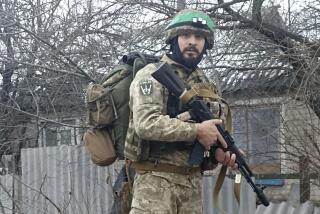Eruption Injures 36 in Colombia; Quake Blamed
- Share via
BOGOTA, Colombia — The second strong earthquake to hit Colombia in as many days caused at least two deaths Sunday and apparently triggered the violent eruption of a volcanic mound that left at least 36 people suffering from burns, authorities reported.
A 1,500-foot-high volcanic mound erupted near the northwestern Colombian village of San Pedro de Uraba, burying several houses and showering residents with burning lava, mud and rock. A Colombian official in Bogota said the eruption was apparently set off by one or both of the weekend quakes.
The magnitude 7.2 temblor struck at 11:13 a.m. local time, causing damage to buildings and injuring people in cities and towns across western Colombia.
The quake’s epicenter was about 185 miles northwest of Bogota, according to a Colombian seismic institute. A Saturday earthquake with an epicenter in the same sparsely populated region had a magnitude of 6.6 and caused several injuries but no reported deaths.
On Sunday, “when the earth started shaking, we saw a sudden blaze of fire that shot up from the volcano,” said Teofilo Santana, a San Pedro de Uraba municipal councilman, in a radio interview. “It burned and split the earth about a kilometer (five-eighths of a mile) around the volcano and buried at least three people.”
Omar Dario Cardona, head of the government’s office for prevention of natural disasters, said that “the earthquakes of (Saturday and Sunday) may have produced decompression of the volcano’s internal gases, leading to its activation and the eruption.”
Sunday’s earthquake killed a small girl in the town of Vigia del Fuerte, 100 miles northwest of Medellin, when a building collapsed on top of her, the Red Cross reported. Authorities in the western city of Pereira reported that a 60-year-old woman died of a heart attack during the earthquake, which lasted nearly two minutes.
There were conflicting reports about casualties caused by the volcanic mound’s eruption, which scorched a wide area near San Pedro de Uraba, about 125 miles northwest of Medellin, capital of Antioquia state. Late Sunday, Gov. Juan Gomez Martinez of Antioquia dismissed widespread initial reports that at least 25 people were missing and presumed dead as a result of the eruption, saying no deaths had been confirmed.
However, San Pedro de Uraba’s mayor, Alcides Caballero, said in a later interview with a local radio network that four people died when they were buried under falling lava, rock and ash. He added that seven homes were burned down as a consequence of the eruption.
The director of the town’s hospital, Javier Diaz, said that at least 36 people, including 10 children, were being treated at the facility, most of them suffering from first- and second-degree burns. Radio reports said that as many as 40 of the nearly 400 people living near the mound were injured in the eruption. An assistant in the mayor’s office, Nelson Poveda, told Caracol radio network that rescue workers were having a difficult time reaching the scene of the eruption because the earthquake had left wide cracks in the road leading to the volcanic mound, about six miles from the town.
At the Antioquia governor’s office, Gomez said he was preparing to send a helicopter to carry medicine and other supplies to the zone.
“I appeal to all Colombians to help the victims of the earthquake and the eruption with donations of food, bedsheets and other supplies,” Gomez said.
The area of San Pedro de Uraba is known for its thermal baths, but it was not known if any of the casualties were bathing near the volcanic mound at the time of the eruption.
The nearby town of Murindo was severely damaged by Saturday’s earthquake. Colombian radio networks reported that Sunday’s quake had practically destroyed what was left of the town.
Reports of people injured in the second earthquake were still trickling in late Sunday. The wounded included 30 people in the northwestern village of Urrao, where 44 houses were damaged, according to a report by local authorities. The earthquake also injured an undetermined number of people in the towns of Puerto Tejada, Bahia Solano and several suburbs of Medellin.
Authorities were still assessing the damage to homes, churches, schools and government buildings in scores of western Colombian towns.
The second earthquake caused damage as far away from the epicenter as Bogota, where several water pipes were ruptured and many residents ran into the streets in panic.
“I was walking my dog in the park when suddenly I felt everything moving,” said one resident of northern Bogota. “I had to sit down because I thought I was having a dizzy spell and about to faint. Then I saw all the people run out onto the street and I realized what was happening.”
Hours after the earthquake, many of the capital’s residents still lingered in the streets, apparently afraid to return home.
Aftershocks continued to rattle parts of the country. Authorities said that hundreds of aftershocks, 15 of them with magnitudes above 4.0, were recorded in the first 36 hours after Saturday’s pre-dawn quake. And more seismic activity is expected, they said.
The government’s office for prevention of natural disasters recommended Sunday that all scheduled sporting events be postponed. Colombia’s soccer commission postponed all seven matches in Sunday’s scheduled round of a national professional tournament.
More to Read
Sign up for Essential California
The most important California stories and recommendations in your inbox every morning.
You may occasionally receive promotional content from the Los Angeles Times.










